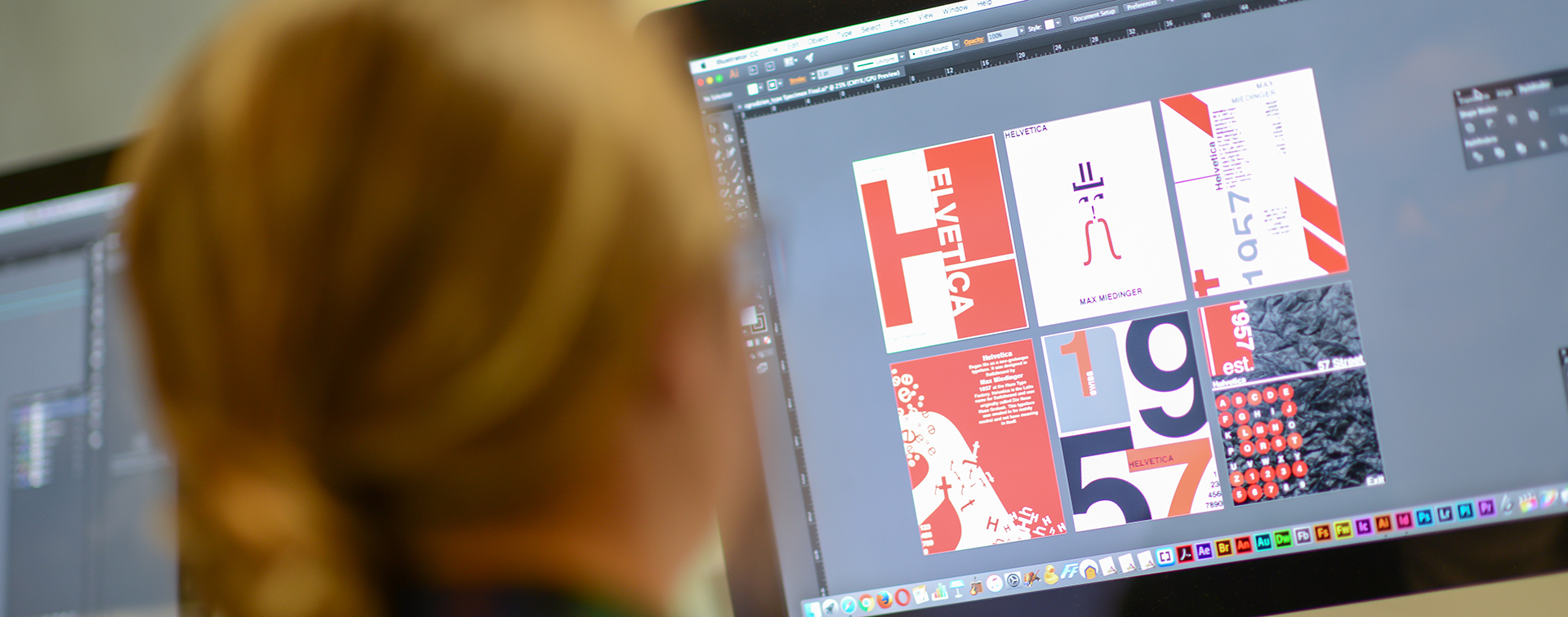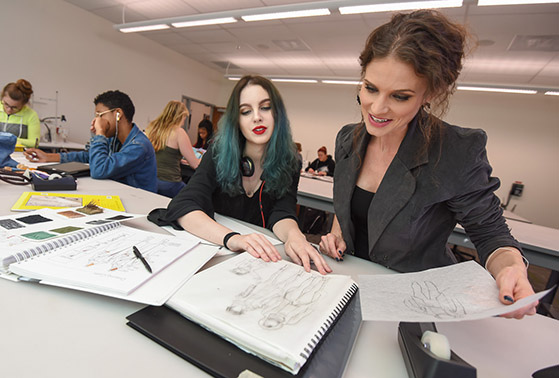Create, Innovate, and Communicate your Ideas to the World
BACHELOR OF SCIENCE OR ARTS
Prepare for a career in marketing communications, publishing, interactive design, digital imaging, or motion graphics. At Stevenson, our graphic design program develops the technical and critical-thinking skills to position you for a successful career in today’s design fields.
Stressing manual skills and applications of evolving technologies, you will be immersed in real-world serious, including academic experiences and professional activities outside of the classroom. Each semester brings a research-based design, producing an interview-ready portfolio by the time you graduate.
Want to go the extra mile? Our Bachelor’s to Master’s Option allows you to graduate with a master’s in as little as five years.
Graduates of the Graphic Design program will:
- Solve design problems by thinking creatively and critically.
- Observe and produce media critically.
- Apply communication and design theory to design practice.
- Justify solutions using research, through written and verbal communication.
- Plan, execute, and revise design solutions considering complex and interdisciplinary elements, including audience, cultural, ethical, human, media, material, and market factors.
- Produce a design portfolio to professional standards.
- Exhibit behaviors consistent with the professional and ethical standards of the discipline both within and beyond the classroom.
The Mill Experience
Stevenson’s Student-Run Design and Communications Agency
The Mill Agency at Stevenson University provides an opportunity for students to work with clients in a collaborative student-driven environment. School of Design, Arts, and Communication majors interact and work on communication and design solutions to meet clients’ needs while collaborating in an agency setting. Students use design thinking to execute professional solutions through research, discussion, iterative making, and formal presentations.
Stevenson Graphic Design
Career Connections
Internship Placements
- Baltimore Magazine
- Children’s National
Medical Center - Kindly RSVP Designs
- Pandora Jewelry
- Synergy Events
Top Employers
- Agora Publishing
- Empire
- United Healthcare
- University of Maryland, College Park
- Wall Street Daily
Graduate Opportunities
- Academy of Art
University, San Francisco, CA - Art Center College of Design
- Maryland Institute College of Art
- Savannah College of Art & Design (SCAD)
- School of Visual Arts, NYC
Career Pathways
- Advertising Design
- Corporate Identity/Brand Design
- Exhibition or Environmental Design
- Special Effects Artist
- Web/Interactive Design

Gain an Extra Competitive Advantage
Open yourself up to additional career paths with one of our professional minors. Each of Stevenson’s professional minors consists of four courses tied to an in-demand industry or profession.
Study Graphic Design at Stevenson
Courses
The courses in the preview below are required for completion of the bachelor’s degree in Graphic Design. Students must complete all remaining major requirements in addition to the Stevenson Educational Experience (SEE) courses.
Course Preview
| ART 110 | Fundamentals of Design I | 3 credits |
| FMI 101 | Cinema I: Storytelling | 3 credits |
| PHOTO 141 | Basic Digital Photography | 3 credits |
| GDES 208 | Web Design I | 3 credits |
| GDES 210 | Graphic Design I | 3 credits |
| GDES 230 | Typography I | 3 credits |
| GDES 410 | Portfolio & Professional Development | 3 credits |
Academic Catalog
Explore our academic catalog for a full listing of courses, course descriptions, and suggested course sequence for Stevenson’s Graphic Design program.
Major Requirements
| FYS 100 | First Year Seminar | 1 credit |
| ART 106 | Introduction to Art History | 3 credits |
| ART 110 | Fundamentals of Design I | 3 credits |
| ART 113 | Fundamentals of Design II | 3 credits |
| ART 116 | Drawing I | 3 credits |
| ART 117 | Drawing II | 3 credits |
| ART 205 | Graphic Design History | 3 credits |
| FMI 101 | Cinema I: Storytelling | 3 credits |
| PHOTO 141 | Basic Digital Photography | 3 credits |
| GDES 125 | Fundamentals of Digital Media | 3 credits |
| GDES 208 | Web Design I | 3 credits |
| GDES 210 | Graphic Design I | 3 credits |
| GDES 211 | Graphic Design II | 3 credits |
| GDES 230 | Typography I | 3 credits |
| GDES 290 | Internship Preparation | 1 credit |
| GDES 308 | Web Design II | 3 credits |
| GDES 310 | Graphic Design III | 3 credits |
| GDES 330 | Typography ll | 3 credits |
| GDES 390 or SOD 390 | Internship | 3 credits |
| GDES 410 | Portfolio & Professional Development | 3 credits |
| GDES 445 | Senior Capstone Research Studio | 3 credits |
| GDES 450 | Senior Capstone | 3 credits |
| Studio Elective (3 credits)* | ||
| Studio Elective (3 credits)* | ||
| Studio Elective (3 credits)* |
*Studio electives include 200-400 level courses in ANIM, ART, GDES, IAD, PHOTO, or SOD 395. Students must choose courses from at least two different course prefix designators.
Minors and Other Options
Minor in Graphic Design
The minor in Graphic Design requires successful completion of a minimum of six courses and 18 credits of courses in graphic design and related disciplines. Graphic design courses encompass a variety of media from print design to screen-based applications. Students in the minor may participate in collaborative work, client-based projects, interactive development, user-experience design, branding strategies, rich-media experiences, visual storytelling, and problem solving through the design thinking process.
Minor in Photography
The minor in photography requires successful completion of a minimum of six courses and 18 credits with a PHOTO prefix.
While learning professional skills in fine art and commercial photography, students will explore topics such as advanced camera functions, studio lighting, visual storytelling, historic processes, and digital imaging. All course prerequisites must be met to be eligible to take the selected course for a minor. Please see the chair of the Department of Graphic Design for more information.
All course prerequisites must be met to be eligible to take the selected course for a minor. Please see the chair of the Department of Graphic Design for more information. General information regarding minor requirements may be found in the minors section of the catalog.
Add a Professional Minor
Open yourself up to additional career paths with one of our professional minors. Each minor is designed to pair with students’ majors to give them additional career options, a competitive edge in the job market, and an opportunity to shape their Stevenson experience to meet their specific career goals.
BA Option
Students also have the option of completing a Bachelor of Arts degree in Graphic Design. The student must fulfill all SEE requirements, program requirements, and complete two semesters of a foreign language from the point of placement or completion of 202 level.
Bachelor’s to Master’s Option
BS/MS options are available for students majoring in Graphic Design who wish to combine their bachelor’s coursework while working toward a Stevenson University Master’s Degree in one of the following:
Visual Arts and Design Portfolios
Students planning to major in Fashion Design, Film & Moving Image, and Graphic Design are allowed to submit a portfolio of work to enhance their application and to be considered for talent-based scholarships.
Scholarship Opportunities
Visual Arts Scholarship
Stevenson’s School of Design offers portfolio-based Visual Arts Scholarships to incoming freshman and transfer students who plan to major in Fashion Design, Film & Moving Image, or Graphic Design.

Rebranding the Observatory
Students from The Mill Agency worked with the Friends of Patterson Park on a rebranding of the park’s iconic Observatory. The students created a new logo, new promotional materials, and even worked with local ice cream shop BMORE LICKS to create an exclusive new flavor, all to reintroduce the Observatory to the public.
Graphic Design News

Portrait and Food photographer Brady Robinson visited the Lighting: Theory and Practice class today for the Editorial Photography workshop.Students had the opportunity to work with Brady Robinson and learn about Flash Photogr.

Special guest Carter Brigham from Corcl boats visited GDES 270- Introduction to Corporate Design classes for a mailer project. During her visit Carter gave students feedback on their ideas and students made several variations.

Special guest Liz Donadio (on the left) taught a Lumen Printing workshop to the students of Prof. Volkova's class Historic Photographic Processes.
Have a Question?
Contact Admissions
Undergraduate Admissions
Owings Mills Campus
Garrison Student Union
North Entrance, Second Floor
1-877-468-6852










